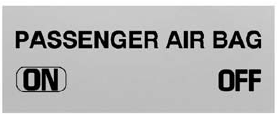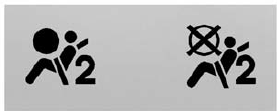Chevrolet Spark Owners Manual: Passenger Airbag Status Indicator
The vehicle has a passenger sensing system. See Passenger Sensing System on page 3-25 for important safety information. The center display has a passenger airbag status indicator.

United States

Canada
When the vehicle is started, the passenger airbag status indicator will light ON and OFF, or the symbol for on and off, for several seconds as a system check. Then, after several seconds, the status indicator will light either ON or OFF, or the on or off symbol to let you know the status of the front outboard passenger frontal airbag and knee airbag.
If the word ON or the on symbol is lit on the passenger airbag status indicator, it means that the front outboard passenger frontal airbag and knee airbag are allowed to inflate.
If the word OFF or the off symbol is lit on the passenger airbag status indicator, it means that the passenger sensing system has turned off the front outboard passenger frontal airbag and knee airbag.
If, after several seconds, both status indicator lights remain on, or if there are no lights at all, there may be a problem with the lights or the passenger sensing system. See your dealer for service.
Warning
If the airbag readiness light ever comes on and stays on, it means that something may be wrong with the airbag system. To help avoid injury to yourself or others, have the vehicle serviced right away. See Airbag Readiness Light on page 5-11 for more information, including important safety information.
 Airbag Readiness Light
Airbag Readiness Light
This light shows if there is an electrical problem with the airbag system. The
system check includes the airbag sensor(s), passenger sensing system, the pretensioners
(if equipped), the airbag mod ...
 Charging System Light
Charging System Light
This light will come on briefly
when the ignition is turned on, and the engine is not running, as a check to show
it is working.
It should go out when the engine is started. If it stays on, or c ...
Other materials:
Windshield Wiper/Washer
The windshield wiper/washer lever is on the right side of the steering column.
Move the lever to one of the following positions: HI: Use for fast wipes.
LO: Use for slow wipes.
INT (Intermittent Wipes): Move the lever up to INT for intermittent wipes, then
turn the INT band up for more ...
Door Locks
Warning
Unlocked doors can be dangerous.
Passengers, especially children, can easily open the doors
and fall out of a moving vehicle. When a door is locked, the handle will not
open it. The chance of being thrown out of the vehicle in a crash is increased
if the doors are not locked. S ...
License Plate Lamp
Attachment Screws
License Plate Bulb
Bulb Socket
To replace a license plate lamp bulb:
Remove the two screws (1) from the license plate lamp assembly.
Turn and pull the license plate lamp assembly down.
Turn the bulb socket (3) counterclockwise and pull it out of the lamp assem ...
